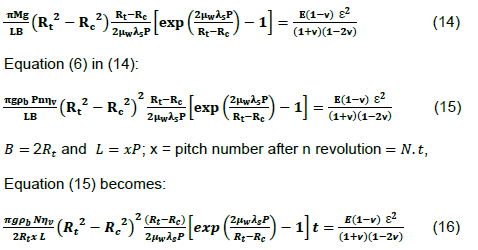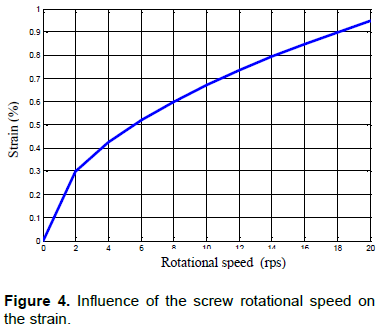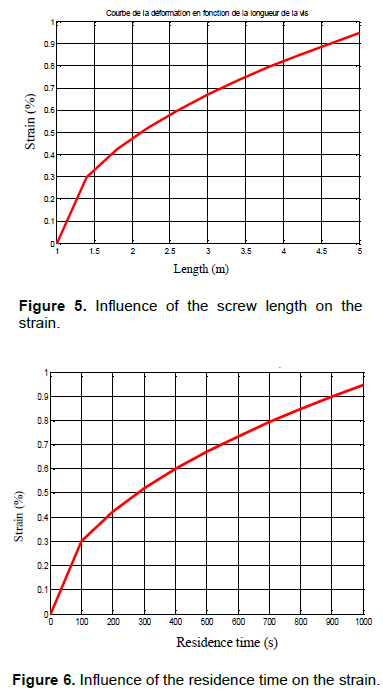ABSTRACT
The aim of this study is to model screw feeder unit to handle granulated wet cassava to the flash dryer column. The knowledge of the flow behavior, physical and mechanical properties, rheology of the product and the geometrical characteristics of feeders unit were essential to evaluate the best conditions of handling granulated cassava based on the theory of virtual works. The effect of granular media strain on the rotational speed which is limited to 2 rps corresponding to the elastic limit of 30% was studied. With the same strain limit, maximum screw length of 1300 mm and the maximum residence time of 100 s in the bin were identified as the best area used to design the screw feeder unit and conduct the process operation. The modeling of the strain was based on the theory of virtual works or energies.
Key words: Modeling, virtual works, strain, screw feeder, cassava.
The screw feeder is one of the most useful feeding devices which not only has good metering characteristics, but also uses relatively simple components and can be designed to feed many kinds of bulk solids, reliably in a variety of applications. Those materials can be chemical, agricultural, pharmaceutical and mineral. The rheology of the granular media is very important when designing devices in order to avoid blockage, flooding, air lock and others which are the main problems. Rheology is the study of the behavior of material when subjected to stress or strength. Metcalf (1965) considered the mechanics of a screw feeder, concentrating on the rate of delivery and the torque required to feed different types of coal using mining drill rods as screws. The model chosen was that of a rigid plug of material moving in a helix at an angle to the screw axis. A detailed experimental investigation was conducted by Burkhardt (1967). The tests included the effect on the performance of a screw feeder, of the pitch, the radial clearance between the screw flight and trough, the hopper exposure and the head of the bulk solid contained in a hopper. Rautenbach and Schumacher (1987) carried out scale-up experiments with two geometrically similar screws. By dimensional analysis, the relevant set of dimensional numbers was derived for the calculation of power consumption and capacity. More recently, Roberts and Manjunath (1994) analyzed the mechanics of screw feeder performance in relation to the bulk solid draw-down characteristics in the feed hopper. In their study, the force exerted on the screw flights is assumed to be uniformly distributed along the whole feed length and three empirical pressure ratios are used in the determination of the required torque. Problems like metering, unsteady flow rates, bridging, channeling, arching, product inhomogeneity, segregation, high startup torques, equipment wear and variable residence time have been reported by many researchers (Cleary, 2007; Owen and Cleary, 2010; Bortolamasi and Fottner, 2001). In addition, the design and optimization of screw feeder performance is not well understood and has been based on semi-empirical approach, numerical or experimental techniques using dynamic similarities (Bortolamasi and Fottner, 2001). Earlier researchers have investigated the effect of various screw (auger) parameters including choke length (the distance beyond which the screw projects beyond the casing at the lower end of the intake) and pitch-diameter ratio (Ghosh, 1967). Augers with large diameters attain maximum output at lower speeds as compared to those with small diameters. They also reported that for maximum throughput during conveying, longer chokes are necessary. The subject of modelling screw conveying of granular materials with the Discrete Element Method (DEM) Cundall and Strack (1979) is fairly recent.
The model we are going to elaborate will help the constructors of screw feeders unit to take decisions when designing devices in order to ameliorate energy consumption, efficiency of the equipment and the best quality product.
Feeder loads
McLean and Arnold (1979) proposed the simplified approach to evaluate the feeder loads for mass flow bins

which is uniformly distributed over the hopper outlet by the following relation:
Where, N is rotational speed and t the residence time.
Equation 7 must also be introduced in 16 which is the final theoretical model. The characteristics of ¶granulated necessary for the simulation of the equation are shown in¶ Table 1.
Figures 4, 5 and 6 present the same evolution of the strain. Each curve in the figures has two parts.
1. ¶The first part is linear and corresponds to the elastic strain.¶ When N = 0 rps, the screw is stopped corresponding to the strain of 0%. As N (rotational speed) increases up to 2 tr/s, the strain increases also rapidly until elastic limit of 30%. For the same elastic limit, the maximum screw length is 1300 mm according to Figure 5 and the residence time of product in the hopper is 100 s according to Figure 6. In those elastic parts, the product flows normally and keeps well his best quality. In those conditions, the flow operation can avoid blockage, flooding, air lock and the equipment is efficient and effectiveness.
2. The second part is nonlinear corresponding to the plastic strain. In those parts, the deformations increase very slowly with the increase of rotational speed, screw length and residential time in the hopper. It can be concluded that the product is well damaged and affect the flow and the quality. These are the characteristics of poor equipment designed because if the hopper is bigger than the normal, if the length of screw is too long and if the rotational speed is high, then the constrains of the equipment will have time to damage the granulated cassava, transforming it solid nature to liquid. The liquid state of cassava cannot allow the flow in the equipment. The cassava must pass with less time in the screw feeder and must be conducted with low rotational speed in order to keep the quality of the product for the next processing and to enhance the output of the equipment. ¶
The physical properties and structure of the granular matters are often accompanied by modifications of the product which affects the flow directly. The formation of the pasty structure and the interruption of flow in the screw feeder influence the course of drying, the quality of the ended product and reduces the output of the equipment. The choice of operation when designing equipment must be done in the elastic zone to preserve the quality of the product and to allow a better operation of the equipment.
The authors have not declared any conflict of interests.
REFERENCES
|
Bortolamasi M, Fottner J (2001). Design and sizing of screw feeders. In: Proc. Partec 2001. Int. Congr. Particle Technol. 69:27-29.
|
|
|
|
Burkhardt GJ (1967). Effect of pitch, radial clearance, hopper exposure and head on performance of screw feeders. Trans. ASAE. 10:685-690.
Crossref
|
|
|
|
|
Cleary PW (2007). DEM modelling of particulate flow in a screw feeder Model description. Progr. Comput. Fluid Dyn. Int. J. 7:128–138.
Crossref
|
|
|
|
|
Cundall PA, Strack ODL (1979). A discrete numerical model for granular assemblies. G’eotechnique 29(1):47-65.
Crossref
|
|
|
|
|
Ghosh BN (1967). Conveyance of wet parchment coffee beans by an auger. J. Agric. Eng. Res. 12(4):274-280.
Crossref
|
|
|
|
|
McLean AG, Arnold PC (1979). A simplified approach for the evaluation of feeder loads for mass flow bins. Powder Bulk Solids Technol. 3(3):25-28.
|
|
|
|
|
Metcalf JR (1962). The mechanics of the screw feeder, Proc. Inst. Mech. Eng. 180(6):131-146.
|
|
|
|
|
Owen PJ, Cleary PW (2010). Screw conveyor performance: comparison of discrete element modelling with laboratory experiments. Progr. Comput. Fluid Dyn. Int. J. 10(5):327-333.
Crossref
|
|
|
|
|
Rautenbach R, Schumacher W (1987). Theoretical and experimental analysis of screw feeders. Bulk Solids Handling 7(5):675-680.
|
|
|
|
|
Roberts AW, Manjunath KS (1994). Volumetric and torque characteristics of screw feeders, Proc. Powder and Bulk Solids Conf., Chicago, IL, USA. pp. 189-208.
|
|
|
|
|
The International Commission of Agricultural Engineering (1999). (CIGR Handbook) of Agricultural Engineering Volume IV Agro-Processing Engineering Michigan State University, USA.
View
|
|
|
|
|
Yu Y, Arnold PC (1996). Influence of screw feeders on bin flow patterns. Pow. Technol. 88:81-87.
Crossref
|
|
|
|
|
Yu Y, Arnold PC (1997). Theoretical modeling of torque requirements for single screw feeders. Pow. Technol. 93:151-162.
Crossref
|
|










